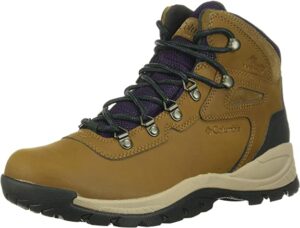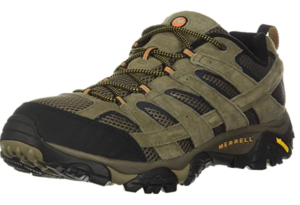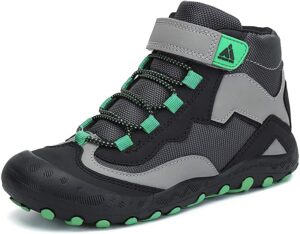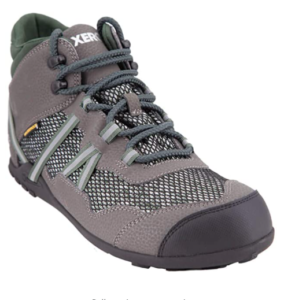Best Hiking Shoes
Best Hiking Shoes for Women

Best Hiking Shoes for Men

Best Hiking Shoes for Kids

You have your water bottle and walking sticks in hand, but more importantly you need a proper pair of hiking shoes or boots before hitting the trails. In order to make the right decision for your situation, there are a few things to keep in mind when shopping —
Different types of hiking shoes
Hiking shoes
Your generic low-cut hiking shoe models are usually a sturdier version of a running shoe. They’ll have flexible midsoles and more tread on the outsole, give you better traction and stability, and are perfect for short hikes without a lot of rough footing. You can find options made of heavy-duty fabric or leather that sometimes have a waterproof or moisture-wicking line on the inside to keep your feet dry and comfortable as you hike.
Hiking boots
Your next step up are hiking boots rather than shoes. These can be either mid- or high-cut (think right at or just above the ankle) and are intended for longer day hikes — especially the hikes that have rockier footing — or light backpacking trips. They’re usually designed with tapered plastic insoles or half-length shanks to give the sole more durability and offer you more support than a hiking shoe.
Backpacking boots
If you need something even sturdier than your everyday hiking boots, you’ll want backpacking boots. These boots are designed to be high-cut above the ankle for support with stiffer midsoles to handle heavier loads and multi-day trips on tough terrain. They’re best known for the durable full-leather upper material and excellent traction, and most usually offer some insulation and waterproofing. You won’t want to wear these boots on full-stride day hikes (trust us, you’re just asking for blisters), but they’re perfect on steep terrain and more technical trips that force you to take shorter steps.
That being said, you’ll want to make sure these boots are well broken in before taking them on long trips (once again, you’d be asking for painful blisters).
What makes a good hiking shoe?
Uppers
The materials used to make a hiking shoe or boot significantly impact its weight, breathability, durability, and water resistance. There are a variety of materials that can be included in the design process:
- Full-grain leather is incredibly durable and water resistant, and it’s not as light or breathable as other materials. It’s most commonly found in backpacking boots that need to handle multi-day trips, heavy loads, and rugged terrain. You’ll want a good amount of break-in time before wearing full-grain leather boots on long trips.
- Split-grain leather “splits away” the rough inner part of a cowhide from the smooth exterior. It’s typically paired with nylon or nylon mesh to offer excellent breathability and is lighter in weight than full-grain. Split-grain is cheaper in price, but will be less resistant to water and general wear and tear.
- Polyester, nylon, and “synthetic leather” are very common in hiking shoes and boots thanks to the light weight, quick break in time, breathability, and lower price point. They aren’t nearly as durable as leather, so they may show wear and tear sooner.
- Waterproof membranes (such as Gore-Tex® or eVent®) are used in hiking boots and shoes to keep your feet dry when you run into wet conditions. These membranes, however, reduce overall breathability and may lead your feet to sweat on hot days.
- Vegan hiking boots and shoes are made without any animal ingredients or materials.
- Synthetic insulation is added to some backpacking boots for warmth when hiking on cold days or in snowy conditions.
Midsoles
The midsole of a hiking shoe or boot provides cushioning, protects your feet from ground impact, and helps determine its overall stiffness. Stiff boots might sound unappealing, but they greatly help to stabilize your feet during hikes on rough, uneven terrain. There are two main types of midsoles found in hiking boots:
- EVA midsoles are slightly cushier, lighter, and less expensive. The density can vary on different parts of the midsole (i.e. around the heel or forefoot) when more support is needed.
- Polyurethane midsoles are usually firmer and more durable. These are typically what you’d want in your backpacking boots for multi-day trips and rockier terrain.
Internal support
Along with midsoles, there’s more that goes into the internal support of a hiking shoe and boot to give you the best stability possible while hiking.
- Shanks are 3-5mm thick inserts between the midsole and outsole to add stiffness and stability. Boots can come with half- or full-length, depending on the model and what level of stiffness you want.
- Plates are thin, flexible inserts between the midsole and the outsole (also below the shank if present) that help protect your feet when stepping on rocky or rough terrain.
Outsoles
Rubber is used on all hiking boot and shoe outsoles. Some outsoles, especially on backpacking boots, can add materials like carbon for extra toughness. Having hard outsoles will increase the boot’s durability, but they can feel slick if you end up off trail. A couple components of an outsole include:
- Lugs are the bumps and grooves on the outsole that give you traction. You’ll find thicker and deeper lugs on heavier duty backpacking boots to give excellent grip on technical terrain. Widely spaced lugs give you good traction and won’t collect mud as easily as tightly compacted lugs.
- Heel brakes are the clearly defined heel areas on your boots that give you extra traction and reduce your chances of slipping or sliding down steep trails.
Best Hiking Shoes for Women

These lightweight hiking shoes created by outdoor enthusiast brand Columbia are designed for women’s feet to keep you comfortable and secure on your hikes. They have a durable and cushioned midsole for comfort and a high-traction Omni-Grip outsole to keep you slip-free on any surface. The full-grain leather and mesh material combination makes them waterproof, durable, and breathable for three-season use. So lace these mid-cut hiking shoes up and hit the trail with confidence.
Best Hiking Shoes for Men

The Merrel Moab hiking shoes are made with leather and mesh uppers and a closed-cell foam tongue to keep moisture and debris out while providing optimal breathability. They come with a removable contoured insole with extra heel and arch support and a cushion pod for support. The EVA foam midsole offers the right balance of stability and comfort and the high-performance outsole gives you unmatched stability and slip resistance so you can adventure worry-free.
Best Hiking Shoes for Kids

You can take the whole family on a hike with these kids hiking shoes from Mishansha. They’re made from an environmentally friendly artificial leather that makes cleaning them a breeze and keeps them lightweight for comfortable wearing. A sturdy TPR toe guard protects your child’s feet and the rubber outsole reduces the risk of them slipping or falling while playing outdoors. These hiking shoes are easy to put on and take off and fit snugly on their feet thanks to a hook-and-loop strap closure. Just grab and go and hit the trails with the kiddos!
Best Vegan Hiking Shoes

You can look good and feel good with these vegan hiking shoes from Xero. They are high-topped for great support and offer a XERO-drop sole for a non-elevated heel that keeps you low to the ground for better balance. The FeelTrue rubber outsole protects your feet, but still lets you feel and connect with the ground with every step. The animal-free materials are waterproof, lightweight, and flexible to let your feet bend and move naturally while staying durable and secure, no matter what trek you take them on.
FAQs about Hiking Shoes
How do I make my hiking shoes last?
Here are a few things you can do to keep your hiking shoes and boots trail-ready for many years:
- Frequently waterproof them with wax or silicone treatments. This will not only keep them waterproof, but it helps soften any leather to make them more comfortable and supple.
- Recondition your boots after hikes and use boot trees to help keep their shape.
- Exposure to water can degrade and shrink the leather without proper conditioning or waterproofing, so avoid submerging shoes or boots that aren’t waterproof.
Why are the soles of my feet so sore even if my hiking shoes fit well?
Your soles can feel sore and bruised after hiking a lot of miles, especially at the balls of your feet or on your heels. This is due to the repeated pressure from hard surfaces and likely means your boot’s insoles aren’t providing good enough padding. Most boots off the shelf won’t have the best insole padding for everyone.
You can purchase replacement insoles that offer different thicknesses and materials or ones that are for specific uses. If possible, bring your boots with you when buying the new insoles so you know there will be enough room in your boot for them without causing toe pinching or foot squeezing.
How can I prevent blisters?
We’ve all experienced blisters at one point or another when breaking in new hiking boots. Blisters form as a reaction to friction — if on your heels, it likely means the heel cup is too wide for your foot; if they’re on the top of your toes, your boots are too long — and proper fit can lessen the chance of experiencing them.
You can also invest in proper hiking socks. Steer clear of socks with bulky toe seams and ones that are too tight or too loose, or grab some thin polypropylene liners to go under your socks to help reduce friction and sweat.
What kind of socks should I wear with my hiking shoes?
Good hiking socks will be made of wool or synthetics that are tough and will dry quickly. There are also waterproof socks specifically for those wet conditions you can’t avoid. You can wear thinner wool socks during the warmer months and thicker ones to help keep your toes warm in the winter, but make sure heavier socks won’t cause your boots to fit too tightly and cause friction. (Some people will even buy a size up in winter hiking boots to allow for thicker socks.)

